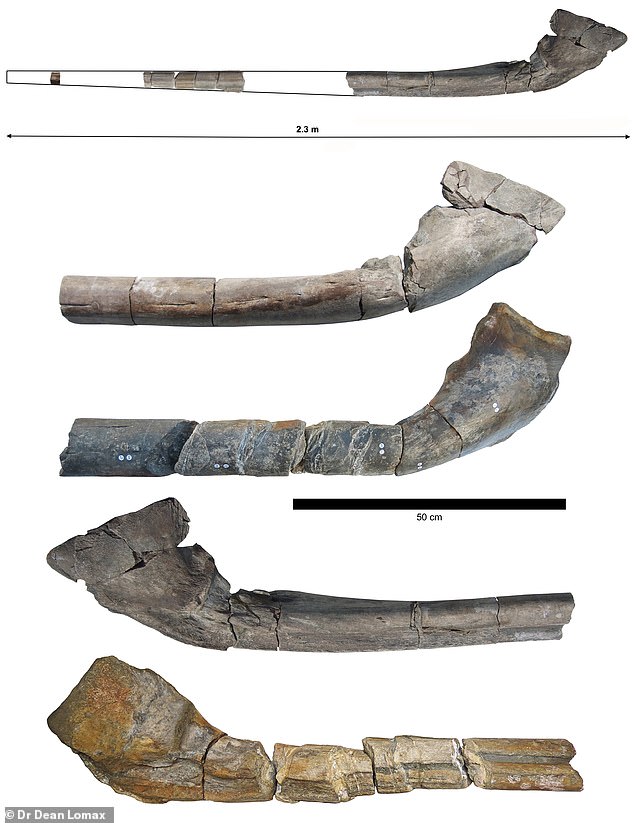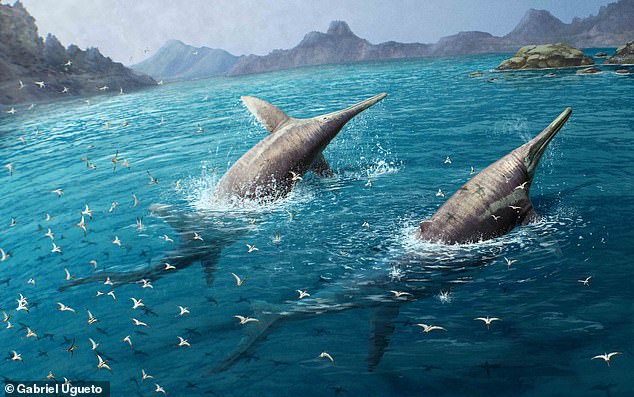Somerset’s Giant Sea Monster! Huge ichthyosaur, twice the size of a London bus, roamed Britain 200 million years ago, study reveals
- Somerset’s coastline was home to a huge ichthyosaur 200 million years ago
- It was no less than 25 meters long, twice as long as a London bus
It is best known for Glastonbury, cider and cheddar.
But Somerset now has a new claim to fame: its coastline was once home to the largest species of marine reptiles ever discovered.
Experts have revealed that a huge ichthyosaur, twice the size of a bus, swam in the sea near Somerset 200 million years ago.
Archaeologists from the University of Bristol and the University of Manchester have in recent years pieced together fragments of a jawbone excavated from the Westbury Mudstone Formation.
The new bone was similar in size and shape to another jawbone collected from the same rock formation just a few miles away.
It is best known for Glastonbury, cider and cheddar. But Somerset now has a new claim to fame – as its coastline was once home to the largest species of marine reptiles ever discovered

Archaeologists from the University of Bristol and the University of Manchester have in recent years pieced together fragments of a jawbone excavated from the Westbury Mudstone Formation.
Together, they now believe that these two jawbones belong to a previously undescribed species of ichthyosaur – a group of enormous, ocean-dwelling reptiles from the age of dinosaurs.
Based on the length of these bones, the new species, named Ichthyotitan severnensis, could have been as long as 25 meters – twice the length of a London bus.
Ichthyosaurs, many of which resemble modern dolphins, first evolved during the Early Triassic, about 250 million years ago.
They are distant relatives of lizards and snakes and could move through the water at very high speeds.
They hunted a range of animals, such as octopus, squid and cuttlefish, with the long, thin jaws containing numerous sharp teeth.
Within a few million years, some had evolved to lengths of at least 15 meters (49 feet), and by the Late Triassic the largest ichthyosaurs had evolved, including the newly described species.

The new species, called Ichthyotitan severnensis, may have been as long as 25 meters – twice the length of a London bus

The fossils were unearthed in the Westbury Mudstone Formation, just southwest of Bristol
However, this reign did not necessarily last long.
While some species of ichthyosaurs continued to roam the oceans for millions of years, these “giant ichthyosaurs” are thought to have become extinct in a major extinction event 200 million years ago.
This unique group of reptiles has never again reached such a gigantic size.
Dr. Dean Lomax, who led the research, said: ‘In 2018 my team studied and described (a) giant jawbone and we had hoped that one day another would come to light.
‘This new specimen is more complete, better preserved and shows that we now have two of these gigantic bones with a unique shape and structure.
‘It’s quite remarkable to think that giant ichthyosaurs the size of a blue whale swam in the oceans around the British Triassic.
‘These jawbones provide tantalizing evidence that a complete skull or skeleton of one of these giants may one day be found. You never know.’
The findings have been published in the journal Plos One.
